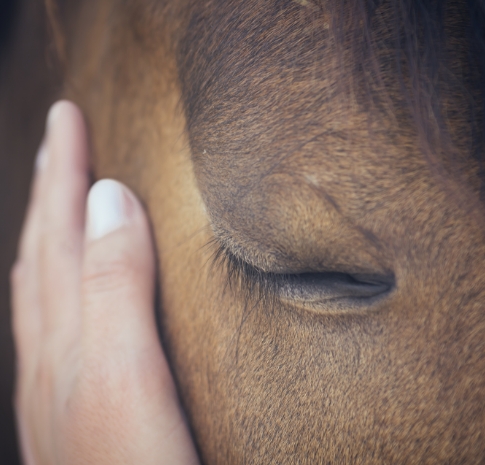PREVENTATIVE CARE
DAILY HEALTH CHECKS
Learning how to recognise when your horse is not feeling well is an important skill to develop. Just like in humans, signs of illness can include things like loss of appetite, lethargy or tiredness, fever, nasal discharge, diarrhoea or constipation. If you know your horse well, you will probably be able to notice when something is not quite right. A sick horse may stand towards the back of its stall, with its head down and ears not erect. It may appear depressed and not respond as quickly or as enthusiastically to your voice or other stimuli. Some horses may refuse their grain but may continue to pick at their ration of hay. If kept with other horses, a sick horse often separates itself and travels well behind the others, or fails to follow at all. Read on for more information about the simple things you can do as part of a daily health check for your horse including:
- Physical examination
- ‘TPR’ (Temperature, Pulse and Respiration)
Physical Examination
A quick daily check of your horse can give you valuable information about his or her health.
What colour are the mucous membranes?
Examining your horse's mucous membranes (the soft lining of the mouth, around the eyes and vulva) only takes a couple of seconds and can help detect general health problems:
- Healthy mucous membranes should be moist and pink in colour.
- Dark red, purple or greyish coloured mucous membranes can suggest infection or blood poisoning
- Pale pink to whitish mucous membranes can suggest anaemia (either because of an underlying disease or due to blood loss)
- Yellowish or orange mucous membranes may suggest jaundice (from liver problems).
TIPS
- Press the gums and count. Peeling back your horse's lips with one hand, use the thumb of the other hand to press into the gums then release. You'll see a pale patch where your thumb was that soon returns to its normal colour. In a healthy horse, it should only take 1-2 seconds for the colour to return to normal. If it takes longer (e.g. 3 seconds or more), this could indicate a number of conditions like dehydration, shock or an underlying disease.
- Listen up. If you have a stethoscope, next time your vet is visiting, ask him or her for a quick lesson on listening to the sounds of your horse’s intestinal tract. Gurgling sounds are completely normal and should be heard on both sides of your horse's flank. These sounds can decrease in some types of colic, or increase in others. So it's important to become familiar with what your horse sounds like when he or she is healthy, so you can spot changes that might indicate a problem and when you need to contact your vet
TPR – TEMPERATURE, PULSE AND RESPIRATION
When we go to a doctor, a check of our temperature, pulse and respiration (breathing) can give the doctor a quick snapshot of our health. Similarly, taking your horse’s temperature, pulse and respiration each day helps you recognise what is normal, so that you can spot any problems.
TIPS
- Temperature. A rectal thermometer is used to take your horse's temperature. Lubricate the bulb with mineral oil, petroleum jelly, liquid soap or vegetable oil. Always hold on to the other end of the thermometer while it is in place (or have a string tied on to it) and stand to the side of your horse (not directly behind). Your horse should be appropriately restrained while you take the temperature, preferably by having someone at the horse's head. Leave the thermometer in place for about 3 minutes (some thermometers will beep when the reading is complete). The normal temperature of a horse is usually between 37.5°C and 38.5°C. Try to take your horse's temperature at the same time each day to minimise any variation. Once you've finished, clean the thermometer (especially if you think your horse is sick) to reduce the risk of spreading any illness.
- Respiration The number of breaths each minute (the respiratory rate) is taken simply by observing your horse at rest and counting the number of inhalations or exhalations. Just look for the chest moving in and out with each breath. If you have a stethoscope, you can listen over your horse's windpipe and count each breath. The normal resting respiration rate for an adult horse is around 10-14 breaths per minute. By undertaking these simple, yet effective, measures you can better understand your horse and have a better idea of when it is important to contact your local vet for professional advice.

Don't Wait to Vaccinate
STAY SAFE AND UP TO DATE - LEARN MORE ABOUT WHEN TO VACCINATE
LEARN MORE